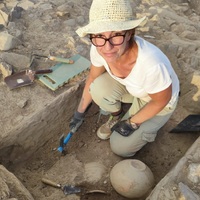Papers by Kathlyn (Kara) Cooney
Routledge eBooks, Aug 1, 2022

e editors are first of all grateful to the contributors themselves, who so patiently endured an e... more e editors are first of all grateful to the contributors themselves, who so patiently endured an endless stream of email queries and "gentle reminders." eir enthusiasm for the project truly made this a "joyful" experience. We would also like to thank those who aided in the preparation of this volume. Katherine Davis, a graduate student in Egyptology at Johns Hopkins, helped enormously during the complicated editing process. Not only has Katherine been a keen-eyed reader of manuscripts, but she also resolved problems of computer fonts and overcame other technological obstacles. We are further indebted to Deborah Shieh, a recent graduate of UCLA, who provided important support to the editors and designed the cover of the book. James (Jay) T. VanRensselaer, the Johns Hopkins University Senior Photographer, who has been a participant in Betsy' s excavations for years, kindly made available most of the images of Betsy published in this volume. We also thank Vonnie Wild, Senior Administrative Coordinator for the Department of Near Eastern Studies (JHU), and Glenda Hogan, Academic Program Coordinator for the Department of Near Eastern Studies (JHU), who both assisted in this project. It is a pleasure as well to acknowledge our debt to Sanchita Balachandran, Violaine Chauvet, Janet Johnson, Leslie Schramer, JJ Shirley, and Mark Smith, who have offered very useful insights and help in the project. Arielle Kozloff and Larry Berman kindly provided the wonderful images of Betsy at the British Museum and Sedinga Temple that follow the introduction. We thank Diana Craig Patch (Curator in Charge of Egyptian Art at the Metropolitan Museum) and Catharine Roehrig who arranged for us to use the image of the beautiful head of Amenhotep III Metropolitan Museum no. 56.138 on the cover of this volume. Christina Di Cerbo advised on many points of the editorial process, especially with regard to the selection of images accompanying this introduction. As always, she has been a tremendous source of encouragement. Finally, what is a book without a publisher? e editors were fortunate to have found in Billie Jean Collins of Lockwood Press an ideal collaborator. Her skill and experience were an invaluable resource to the editors through the years of work on the volume. Billie Jean' s unfailing support for the project is profoundly appreciated. May all editors be as lucky!

Introduction (Carolyn Graves-Brown) The Problem of Female Rebirth in New Kingdom Egypt: The Fragm... more Introduction (Carolyn Graves-Brown) The Problem of Female Rebirth in New Kingdom Egypt: The Fragmentation of the Female Individual in Her Funerary Equipment (Kathlyn M Cooney) Queering Sex and Gender in Ancient Egypt (Thomas A Dowson) Power on their own: gender and social roles in provincial New Kingdom Egypt (Terence DuQuesne) 'People vs. P. Turin 55001' (Jiri Janak and Hana Navratilova) Breaches of Cooperative Rules. Metaphors and Parody in ancient Egyptian love songs (Renata Landgrafova) Rules of Decorum and Expressions of Gender Fluidity in Tawosret's Tomb (Heather Lee McCarthy) Boasting about Hardness: Constructions of Middle Kingdom Masculinity (R B Parkinson) Queer Egyptologies of Niankhkhnum and Khnumhotep (Greg Reeder) Did Women 'Do Things' in Ancient Egypt? (Circa 2600-1050 BCE) (Carolyn Routledge) The Bearded Woman and the Queen. The Formation and Transformation of Female Divine Classifiers (Racheli Shalomi-Hen) Gender and Requests in New Kingdom Literature(Deborah Sweeney).
Routledge eBooks, Aug 1, 2022

The Oxford History of the Ancient Near East: Volume III
The Ramesside period saw the contraction of Egypt’s hegemony in the ancient Mediterranean, extrao... more The Ramesside period saw the contraction of Egypt’s hegemony in the ancient Mediterranean, extraordinary economic contraction and lessening monumental production, and generations of mass migrations, destabilizing Egypt. The period followed Egypt’s Eighteenth Dynasty, an apex of steady growth, consistent wealth, and high-quality artistic production under able and well-known kings to whom the Ramesside period kings are often compared to their detriment. Should one view the Ramesside period in a different way? Ramesside kings witnessed a steady decline of authority, experiencing palace infighting so intense that it resulted in two civil wars. This period was also punctuated by one of the most devastating social and global apocalypses the Mediterranean and ancient Near East had ever known—the Bronze Age collapse. The fall of the Twentieth Dynasty was part of a larger crisis in economic, political, and climatic systems, not a miscalculation of one or two dynastic families. When the Rames...
The ancient Egyptian scarab is an artistic depiction of the indigenous Egyptian dung beetle. Myth... more The ancient Egyptian scarab is an artistic depiction of the indigenous Egyptian dung beetle. Mythologically, the scarab represented the ability of the sun god to bring about his own rebirth. There are a number of different kinds of scarabs, including heart scarabs, commemorative scarabs, and scarab amulets, indicating their different functions within varying social contexts-from apotropaic to amuletic, socioeconomic, and propagandistic. The blank oval underside of the scarab amulet was an excellent location for the inscription of personal names, kings' names, apotropaic sayings, or geometric or figural designs. Scarabs are extremely difficult to date; very few are found in archaeological context and most are unprovenanced in private and museum collections.
An international group of scholars have contributed to Joyful in Thebes Festschrift for the disti... more An international group of scholars have contributed to Joyful in Thebes Festschrift for the distinguished Egyptologist Betsy M. Bryan. The forty-two articles deal with topics of art history, archaeology, history, and philology representing virtually the entire span of ancient Egyptian civilization. These diverse studies present unpublished material or new interpretations of specific issues in Egyptian history, literature, and art history. Abundantly illustrated with photographs and line drawings, the volume also includes a comprehensive bibliography of Bryan's publications.
Sex and Gender in Ancient Egypt
The Journal of Egyptian Archaeology, 2012
Cooney's The Cost of Death sets out to establish the social and economic value of funera... more Cooney's The Cost of Death sets out to establish the social and economic value of funerary artifacts (particularly coffins) and how such notions of value were arrived at during Ramesside-period Egypt (12951069 BCE). The funerary artifacts are located at the ...
Ancient Egyptian Coffins, 2018
Body, Cosmos and Eternity, 2014
Ancient Egyptian Coffins, 2018
The Tomb of the Priests of Amun, 2018
This discussion will be centered on one ubiquitous and rather simple Egyptian object type – the w... more This discussion will be centered on one ubiquitous and rather simple Egyptian object type – the wooden container for the human corpse. We will focus on the entire 'lifespan' of the coffin – how they were created, who bought them, how they were used in funerary rituals, where they were placed in a given tomb, and how they might have been used again for another dead person. Using evidence from Deir el Medina, we will move through time from the initial agreement between the craftsman and the seller, to the construction of the object by a carpenter, to the plastering and painting of the coffin by a draftsman, to the sale of the object, to its ritual use in funerary activities, to its deposit in a burial chamber, and, briefly, to its possible reuse.

The Journal of Egyptian Archaeology, 2019
In the Twenty-first Dynasty, ancient Egypt was facing a number of economic, political, and religi... more In the Twenty-first Dynasty, ancient Egypt was facing a number of economic, political, and religious challenges and transformations. To compensate for a lack of imported resources and subsidized incomes, the Egyptian people were robbing and reusing the tombs of their predecessors. Royal coffins and mummies were collected by priests and placed in tomb caches, supposedly for their protection. In this article, the authors show how a detailed material analysis of the coffins in these caches can help reveal the social history of Egypt at this time. The coffins of Queen Henuttawy prove to be a combination of Eighteenth and Twenty-First Dynasty construction and decoration, and may provide insight into the actions of Third Intermediate Period priests. Following these pieces through to their modern excavation and display in the Egyptian Museum, Cairo, it is evident that these objects continue to impact lives, acquiring additional layers of history and social significance.
Near Eastern Archaeology, 2010
The Early Bronze IV (ca. 2300-2000 BCE) is a period known for one-phase sites and isolated cemete... more The Early Bronze IV (ca. 2300-2000 BCE) is a period known for one-phase sites and isolated cemeteries. The stratified remains at Khirbat Iskandar, situated on the Wâdi al-Walâ north of Dhiban, offer important data on rural complexity in a sedentary community of the late third millennium BCE. Includes studies of stratigraphy, the environment, artifacts, faunal remains, skeletal remains from t e tom s, an eterm nations, as well as quantitative and petrographic ceramic studies.
American Antiquity, 2006
After about 1,000 years of constructing pyramids for royal burials, Egyptians of the New Kingdom ... more After about 1,000 years of constructing pyramids for royal burials, Egyptians of the New Kingdom (ca. 1550-1069 BC) buried their kings in hidden tombs in the so-called Valley of the Kings. As with earlier state building projects, a town was established for the craftsmen working on the royal tomb and their families. The site of this town, Deir el-Medina in western Thebes, is one of the best preserved settlements from ancient Egypt. After the First World War and up to 1951, French archaeologists excavated at the site, under the direction of Bernard Bruyere, and excavations have recently been resumed by Guillemette Andreu of the Louvre Museum.











Uploads
Papers by Kathlyn (Kara) Cooney